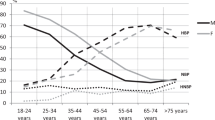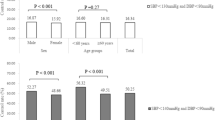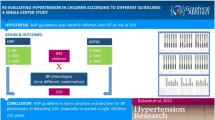Abstract
The purpose of this study was to determine if systolic blood pressure (SBP) by itself is sufficient for the JNC-VI (Sixth Report of the Joint National Committee on Detection, Evaluation, and Treatment of High Blood Pressure)-based classification of blood pressure of Tehranian adult population. Clinically, SBP and diastolic blood pressure (DBP) are sometimes at different stages in the same individual and the higher stage is considered to classify blood pressure level. The prevalence of disparate levels of SBP and DBP has only recently been noticed. Some researches have reported the importance of SBP level, and not DBP, in determining the appropriate classification of hypertension even in those undergoing treatment. Data were collected for 3823 men and 5159 women aged 20–69 years who were not using antihypertensive medication, in the Tehran Lipid and Glucose Study (TLGS), a cross-sectional phase of a large epidemiological study first established in 1999. The study used the mean of two separate blood pressure measurments in each individual. High blood pressure is defined according to the highest level of SBP or DBP. In 86.3% of the subjects, blood pressure stage was determined according to SBP and in 90.0% of them according to DBP. In 77.4% of the subjects (75.7% of men and 78.7% of women), SBP determined blood pressure in the same stage as DBP did. The role of SBP was the most prominent in age groups 20–29 and 60–69 years (91.4 and 90.8%, respectively) and the least in age group 40–49 years (80.4% of the subjects). DBP had a more prominent role in younger ages and the least significance in older ages. In conclusion, SBP has a more prominent role than DBP in determining blood pressure stage according to JNC-VI only in the 60–69-year-old group. The role of DBP is more prominent in other age groups.
This is a preview of subscription content, access via your institution
Access options
Subscribe to this journal
Receive 12 digital issues and online access to articles
$119.00 per year
only $9.92 per issue
Buy this article
- Purchase on Springer Link
- Instant access to full article PDF
Prices may be subject to local taxes which are calculated during checkout

Similar content being viewed by others
References
The Sixth Report of the Joint National Committee on Detection, Evaluation, and Treatment of High Blood Pressure. Arch Intern Med 1997; 157: 2413–2446.
Lloyd-Jones DM et al. Differential impact of systolic and diastolic blood pressure level on JNC-VI staging. Joint National Committee on Prevention, Detection, Evaluation, and Treatment of High Blood pressure. Hypertension 1999; 34: 381–385.
Pogue VA, Ellis C, Mechel J, Francis CK . New staging system of the Fifth Joint National Committee report on the detection, evaluation, and treatment of high blood pressure (JNC-V) alters assessment of the severity and treatment of hypertension. Hypertension 1996; 28: 713–718.
Black HR . The paradigm has shifted, to systolic blood pressure. Hypertension 1999; 34: 386–387.
Izzo JL, Levy D, Black HR . Importance of systolic blood pressure in older Americans. Hypertension 2000; 35: 1021–1024.
Kannel WB, Gordon T, Schwarts MJ . Systolic versus diastolic blood pressure and risk of coronary heart disease. Am J Cardiol 1971; 27: 335–345.
Neaton JD, Wentworth D, for the Multiple Risk Factor Intervention Trial Research Group. Serum cholesterol, blood pressure, cigarette smoking, and death from coronary heart disease: overall findings and differences by age for 316 099 white men. Arch Intern Med 1992; 152: 56–64.
Dustan HP . 50th Anniversary historical article: hypertension. J Am Coll Cardiol 1999; 33: 595–597.
Azizi F, Rahmani M, Emami H, Madjid M . Tehran Lipid and Glucose Study: rationale and design. CVD Prevention 2000; 3: 242–247.
Christiansen DH, Hosking JD, Dannenberg AL, Williams OD . Computer-assisted data collection in multicenter epidemiologic research: The Atherosclerosis Risk in Communities (ARIC) study. Control Clin Trials 1990; 11: 101–115.
Atherosclerosis Risk in Communities Manuals of Operation. No 12, Quality Assurance and Quality Control. ARIC Coordinating Center: Chapel Hill, 1997.
Wilson PW, Kannel WB . Hypertension, other risk factors and the risk of cardiovascular disease. In: Laragh JH, Brener BM (eds) . Hypertension: Pathophysiology, Diagnosis, and Management. Raven press: New York, NY; 1995, pp. 99–114.
Staessen JA et al. Randomised double-blind comparision of placebo and active treatment for older patients with isolated systolic hypertension. The Systolic Hypertension in Europe (Syst-Eur) Trial Investigators. Lancet 1997; 350: 757–764.
Neaton JD, Kuller L, Stamler J, Wentworth DN . Impact of systolic and diastolic blood pressure on cardiovascular Mortality. In: Laragh JH, Brenner BM (eds). Hypertension: Pathophysiology, Diagnosis and Management. Raven Press: New York, NY, 1995, pp. 127–144.
Burt VL et al. Prevalence of hypertesnion in the US adult population. Results from the Third National Health and Nutrition Examination Survey, 1988–1991. Hypertension 1995; 25: 305–313.
Franklin SS et al. Hemodynamic patterns of age-related changes in blood pressure. The Framingham Heart Study. Circulation 1997; 96: 308–315.
Acknowledgements
This research project was supported by a national Grant no. 121 NRCI Research Projects and with the support of the National Research Council of Islamic Republic of Iran. We express appreciation to the participants of district-13, Tehran, for their enthusiastic support of this study. We thank the appreciable work of the social relation unit and steering committee of TLGS for their guidance in preparing this paper. The participation of the staff of the Endocrine and Metabolism Research Center, Tehran Lipid and Glucose Study unit, Health Department of Shaheed Beheshti University of Medical Sciences is gratefully acknowledged. We also thank Dr Bahman Guyuron and Dr Martina Ferraro, who revised the English edition of the manuscript.
Author information
Authors and Affiliations
Corresponding author
Rights and permissions
About this article
Cite this article
Azizi, F., Rashidi, A., Ghanbarian, A. et al. Is systolic blood pressure sufficient for classification of blood pressure and determination of hypertension based on JNC-VI in an Iranian adult population? Tehran lipid and glucose study (TLGS). J Hum Hypertens 17, 287–291 (2003). https://doi.org/10.1038/sj.jhh.1001539
Published:
Issue Date:
DOI: https://doi.org/10.1038/sj.jhh.1001539



